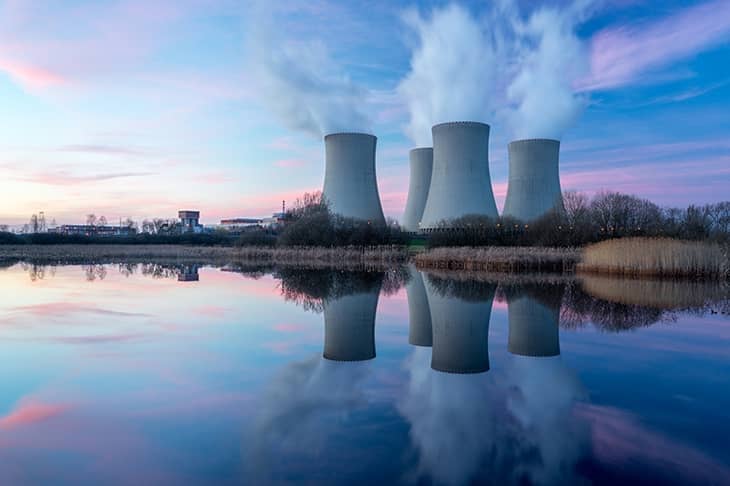Nuclear future
Sir: It is refreshing to see Martin Vander Weyer note that, properly and fully costed, nuclear power is cheaper than power from wind and solar sources (Any other business, 26 March). That is because, as he says, ‘wind and solar require excess capacity and battery storage to compensate for periods of low output’. It cannot be predicted when those periods of low output will occur, and the proportion of our electricity provided by wind at any one time can be anywhere between 2 per cent and 40 per cent.
Martin supports the aim to meet 25 per cent of UK energy needs using nuclear by the net-zero deadline of 2050. However, he has not yet asked the crucial question of where the non-nuclear portion of our energy might come from in 2050. Today, the despatchable fuel which comes to our rescue when the wind stops blowing is gas. But gas is a fossil fuel, so is barred by net-zero rules. Battery storage is massively expensive, with little prospect of a technical breakthrough to significantly reduce its cost. Sufficient batteries to provide 75 per cent of the UK’s power needs during a week-long winter anticyclone would cost trillions. Hydroelectricity is a niche which cannot be readily expanded due to our topography. Burning biomass creates CO2 – indeed the Drax power station is our single biggest creator of it. Hydrogen, tidal and/or carbon capture might come good, but all those technologies are in their infancy and several years away from being proven to work at scale and reasonable cost. It may turn out that none of them does.
The only zero-carbon power source that we know works is nuclear. Given the long lead time on construction of nuclear power stations, if we are serious about achieving net zero, we must prepare ourselves now for 100 per cent nuclear by 2050.
Richard North
Hayling Island, Hampshire
An evolved system
Sir: In his Wiki Man column of 19 March, Rory Sutherland highlights the benefits of evolved systems over those which are designed top-down. He cites as an example a comparison of the general road network in Britain (evolved) with the fear-inducing one-way systems in many motorway service stations (designed).
Perhaps the supreme example of a superior evolved system is the British constitution: part-written down, part-convention, and not codified in any single document, it has grown like a forest. Changing and adapting to meet the needs of every age, constantly renewing itself to remain relevant, yet at the same time completely recognisable as the living, breathing embodiment of a thousand years of history which we have had the great privilege to inherit. Could a committee of lawyers draft anything better? I doubt it.
Adam Kelly
Leeds, West Yorkshire
What are farms for?
Sir: Apart from our failure to maintain a viable military capability, the other major lesson from the war in Ukraine is our need to increase our domestic food security (‘How Ukraine can win’, 19 March).
Food is historically cheap, but the new world order we are going to see means increasing food insecurity and the need to tailor our farming to producing more and paying producers properly.
The current proposals to replace single farm payments with payments for wildlife and conservation need reviewing urgently. Yes, we need to encourage nature and conservation, however re-wilding productive land is not in our long-term interests and should not be encouraged financially. Never has organic farming been more viable, with its many benefits to nature and no need for the fertiliser that is energy-hungry and mostly imported. Will Defra be thinking this way or will it continue to be behind the curve?
Christopher D. Forrest
Yealmpton, Devon
Liberation theology
Sir: In Damian Thompson’s excellent analysis of Patriarch Kirill’s dubious version of nationalistic Orthodoxy (‘Turbulent priest’, 26 March), he characterises liberation theology as ‘an ugly hybrid of Catholicism and Marxism that developed in Latin America’. Surely this is a caricature? While Marxist theory informed the early proponents of this branch of theology, it was counterbalanced by a return to the early Christian emphasis on ‘God’s preferential option for the poor’. Liberation in the 1970s and 1980s was a rallying cry for oppressed people in many countries, where liberal democratic governance was a dream and the atheistic versions of Marxism on offer were a nightmare. Since then churches have rediscovered their role as advocates for the dispossessed; refugees; victims of abuse and the oppressed. Liberation theology may not be perfect but it is at least a salutary corrective to the clerical indifference to pressing moral issues of our day.
The Revd Larry Wright
Kings Norton, Leicestershire
Creatures of habit
Sir: I was intrigued by Jeremy Clarke’s comparison of the different lengths in nuns’ wimples to the stripe in Paul Pennyfeather’s tie that misled Lumsden of Strathdrummond (Low life, 19 March) and admit I had to look up the reference. It reminded me somehow of our first house purchase when a very elderly surveyor produced a report which likened the bannisters in style to ‘the late Sir Henry Lauder’s celebrated walking stick’. I had to look that up too.
Peter Fineman
Mere, Wiltshire
Durham love
Sir: I wonder if I am alone in being confused by reading Professor Forrest’s paean to Durham University (Letters, 26 March) into thinking I had picked up the wrong magazine and was laughing at Pseuds’ Corner?
Robin Briggs
Swanage, Dorset






Comments